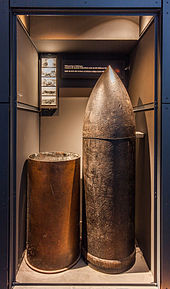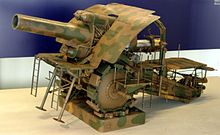Fat Bertha
Big Bertha (including Big Bertha , the French Big Bertha ) the nickname of several German had guns , which for the first time in World War I were used and there among the best known weapons included.
In a narrower sense, the nickname only refers to the M-device with a wheel mount , but partly because of the identical calibres , the 42 cm gamma mortar belonging to the Navy was also given the same name.
In both cases it was a 42 cm mortar that was developed and built by the Krupp armaments company . The two types of gun were each referred to as a short naval cannon , although they were intended for use on land. They should serve to combat fortifications. During the First World War, it became clear that the most modern and strongest fortifications made of reinforced concrete withstood the 42 cm shells, while other structures were penetrated.
Surname
There are no documents about the origin of the name, but it can be assumed that it comes from the spelling alphabet (Bertha for the letter B). A frequently assumed relationship with Bertha Krupp cannot be proven beyond doubt. The background is the humor of the time, which liked to play with common names. Another cannon of the time was called Langer Max . Even for Lange Anna , no historical person can be proven, nor is there any claim made by contemporaries of the origin of the name. Anna and Bertha were very common names for maids too.
costs
A gun cost 1 million marks (equivalent to around 5,320,000 euros today ) and was designed for 2000 rounds. Each shot thus cost around 1500 marks (1000 marks ammunition + 500 marks depreciation ), which corresponds to around 8,000 euros today.
variants
Short marine cannon 12 L / 16 (gamma device)
The gamma device had a total mass of 150 tons and was carried on ten railroad cars.
Five examples had been built by 1912, and another five guns and 18 replacement tubes were added during the First World War.
Short marine cannon 14 ("M-device")
In the designation M device, the "M" stood for mine thrower , although it was actually a mortar . The most noticeable difference to the Gamma device was the wheel carriage for road transport, which could be equipped with wheel belts if required . The M device also had a shorter tube (L / 11.9) than the Gamma device (L / 16). The M-device had a mass of 42.6 tons when ready to fire and was driven in four partial loads using motorized tractors. Two pieces had been produced by 1913, and another ten during the First World War.
Heavy Kartaune ("β-M device")
Since the targets for such heavy artillery were missing after the transition to trench warfare and the range of fire increasingly proved to be inadequate, new uses for the wheel mounts of the M device were sought. After several variants had been examined, a new tube of 30.5 cm L / 30 caliber was finally inserted into the mount. The resulting gun was called the Schwere Kartaune or β-M device . At the end of the war, two batteries equipped with this type of gun stood at the front. With a projectile weighing 333 kg and four partial charges , the maximum firing range was 16.5 km (the use of up to six partial charges was prohibited after several gunshots ).
Bullets

The mortars fired different types of ammunition with delay fuses, whereby the grenade should only be ignited after penetration of the hardened target in order to achieve the greatest possible effect.
The M device fired a heavy shell of 810 kg up to 9,300 m, with the light shell of 400 kg introduced in 1917 it had a range of 12,250 m.
The gamma device fired a light shell from 960 kg at 14,100 m, a heavy shell from 1,160 kg at 12,500 m and a so-called new shell from 1003 kg at 14,200 m. The weight of the explosive charge was around 410 kg for the heavy shells, and 100 kg for the lighter ones.
The impact energy with the M device was about 34 MJ (3500 mt ), with the Gamma device 59 MJ (6000 mt), the muzzle energy 373 MJ (38,000 mt).
Use in the First World War
At the beginning of the First World War , the gun could be used with great success against the older Belgian and French forts, which were made of unreinforced stamped concrete or were only partially reinforced. The use of facilities, such as Fort de Liouville ( Apremont-la-Forêt ) , which were largely still in quarry-stone works was particularly devastating . The fortifications could not withstand the explosive force of the previously unknown caliber.
At the beginning of the war, the Liège fortification ring consisting of twelve forts was considered impregnable. Fortunately for the German attackers, the inner city of Liège was captured on August 5, 1914 . The twelve surrounding forts could only be taken after the heaviest siege artillery with a caliber of 42 cm had been brought in with the Dicken Bertha . When the fat Bertha shot at Fort Loncin , she scored a direct hit in the ammunition chamber on August 15, 1914. The fort then exploded; 350 Belgian soldiers died.
During the siege of Antwerp in September / October 1914, two batteries (short marine cannon batteries 2 and 3) each with two gamma devices were used. The forts Wavre-Sainte-Catherine and Koningshoyckt were shelled by battery 2 and Lier, Kessel and Broechem by battery 3.
The mortars were also used in the Verdun theater of war . Fort Vaux and Fort de Moulainville , among others, were severely damaged. The massive bombardment also destroyed parts that were heavily concreted or armored with steel. After the Verdun use, the pipes were badly worn; a reproduction was not made due to the increasing obsolescence of the gun type.
Use in World War II
According to the Treaty of Versailles , the guns had to be destroyed or handed over to the Allies after the end of the First World War . One of the gamma devices that was on the Krupp test site was overlooked. First used for firing tests in 1936/37, it was reintegrated into the army in 1939 and used in World War II . The first operation took place on June 7, 1942 during the siege of the Sevastopol fortress . In September 1944, the gun was used in the suppression of the Warsaw Uprising . The whereabouts of the gun is unclear.
See also
literature
- Berchtold, Krobatin: Correspondence from November 1914 about the use of the east. Motor batteries in Belgium. Austrian State Archives
- Gerhard Taube: The heaviest deep-fire guns 1914–1945. Secret weapons "Big Bertha" and "Karl". Motorbuch-Verlag, Stuttgart 1981, ISBN 3-87943-811-0 .
- Franz Kosar: The heavy artillery in the world. Field artillery - self-propelled guns - siege guns. Motorbuch-Verlag, Stuttgart 2002, ISBN 3-613-02204-4 .
- Axel Turra: Big Bertha - A 42 cm high-speed cannon becomes a legend. Podzun-Pallas Verlag, Wölfersheim-Berstadt 2001, ISBN 3-7909-0753-7 ( Waffen-Arsenal Special 31).
- Fritz Hahn: Weapons and Secret Weapons of the German Army 1933–1945. Bernard and Graefe, Bonn 1992, ISBN 3-8955-5128-7 .
- Terry Gander, Peter Chamberlain: Encyclopedia of German Weapons 1939-1945. Hand weapons, artillery, prey weapons, special weapons. Motorbuch-Verlag, Stuttgart 1999, ISBN 3-613-01975-2 .
Web links
Individual evidence
- ↑ Gerhard Hirschfeld , Gerd Krumeich , Irina Renz, Markus Pöhlmann (eds.): Encyclopedia First World War. Ferdinand Schöningh, Paderborn 2003, ISBN 3-506-73913-1 , p. 440.
- ↑ Franz Kosar: The heavy guns of the world. Motorbuch Verlag, Stuttgart 2002, ISBN 3-613-02204-4 , p. 65
- ↑ Franz Kosar: The heavy guns of the world. Motorbuch Verlag, Stuttgart 2002, ISBN 3-613-02204-4 , p. 68
- ↑ Franz Kosar: The heavy guns of the world. Motorbuch Verlag, Stuttgart 2002, ISBN 3-613-02204-4 , p. 88 f.
- ↑ http://www.fl18.de/history/139/



